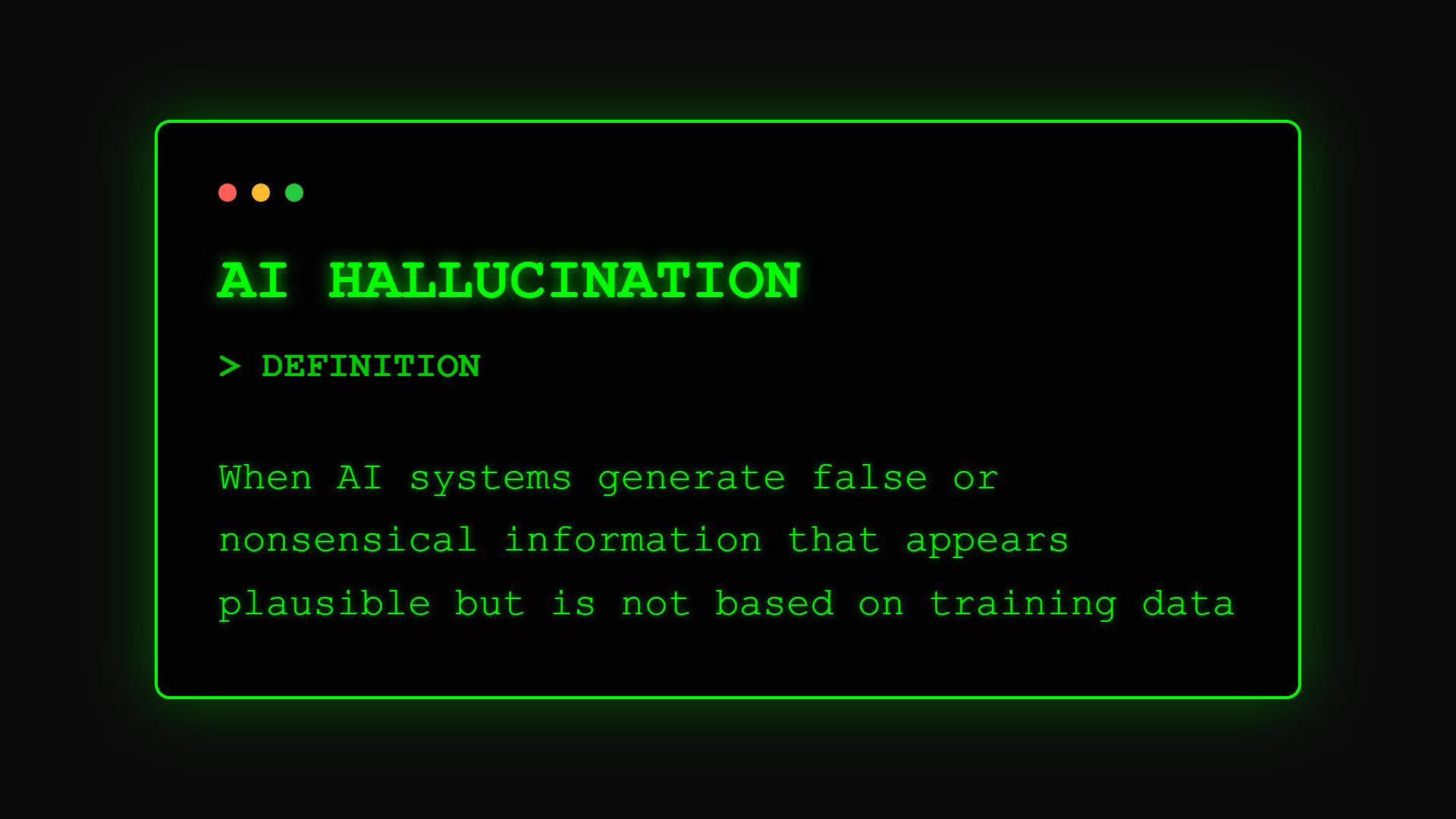AI Terms
What is AI Hallucination? The Hidden Risk in AI Responses

Your AI assistant confidently tells you about a groundbreaking 2019 Harvard study on productivity. There's just one problem: the study doesn't exist. This is AI hallucination, one of the most critical challenges businesses face when deploying AI systems.
Understanding a Peculiar Problem
The term "hallucination" in AI was coined by researchers in 2018 to describe when models generate plausible-sounding but factually incorrect information. Unlike human lies, AI doesn't intend to deceive; it's a fundamental characteristic of how these systems work.
According to Google Research, AI hallucination is defined as "the generation of content that is nonsensical or unfaithful to the provided source content, occurring when models produce outputs based on patterns in training data rather than factual accuracy."
The issue gained widespread attention in 2023 when lawyers were sanctioned for submitting AI-generated legal briefs containing fictional case citations, highlighting the real-world consequences of unchecked AI output.
What This Means for Your Business
For business leaders, AI hallucination means that even the most advanced AI systems can confidently present false information as fact, requiring vigilance and verification processes to ensure reliability.
Think of AI hallucination like a highly knowledgeable colleague who occasionally fills knowledge gaps with educated guesses presented as certainties. They're usually right, but when they're wrong, they sound just as confident.
In practical terms, this means your AI might invent customer testimonials, cite non-existent regulations, or create plausible but incorrect financial data, all while appearing completely authoritative.
Why AI Hallucinates
AI hallucination stems from these fundamental factors:
• Pattern Matching, Not Fact Checking: AI generates responses based on patterns in training data, without a true understanding of truth or access to real-time fact verification
• Training Data Limitations: Models learn from text that may contain errors, biases, or outdated information, reproducing these inaccuracies in outputs
• Probabilistic Generation: AI predicts "likely" next words based on context, which can create coherent but fictional content when combining learned patterns
• Lack of Uncertainty Expression: Current models struggle to say "I don't know," instead generating plausible-sounding responses to fill knowledge gaps
• Context Confusion: Models can blend information from different sources or time periods, creating historically impossible or factually incorrect combinations
How Hallucinations Manifest
AI hallucinations typically appear in these ways:
Factual Fabrication: Creating specific but false details like dates, names, statistics, or events that sound credible but never existed
Source Attribution Errors: Citing real people or organizations but attributing incorrect quotes, studies, or positions to them
Logical Inconsistencies: Generating information that contradicts itself within the same response or violates basic logic while maintaining confident tone
These hallucinations are particularly dangerous because they're often mixed with accurate information, making detection challenging.
Types of Hallucination Risks
Hallucinations pose different risks across contexts:
Type 1: Factual Hallucinations Risk level: High for business decisions Common in: Statistics, dates, scientific claims Example: Inventing market research data
Type 2: Citation Hallucinations Risk level: Critical for legal/academic use Common in: References, quotes, sources Example: Creating fictional legal precedents
Type 3: Instruction Hallucinations Risk level: Moderate to high Common in: Technical procedures, recipes, guides Example: Incorrect configuration steps
Type 4: Creative Elaboration Risk level: Low for creative tasks Common in: Marketing copy, stories Example: Adding plausible but fictional details
Real Business Impact
Here's how AI hallucinations affect businesses:
Legal Example: A New York law firm faced sanctions and embarrassment after submitting a brief with AI-generated fake case citations, damaging their credibility and requiring extensive corrections.
Media Example: CNET had to issue corrections for dozens of AI-generated articles containing factual errors about financial topics, harming their reputation for accuracy.
Customer Service Example: A major retailer's chatbot hallucinated return policies, promising benefits that didn't exist, leading to customer complaints and policy confusion.
Preventing and Managing Hallucinations
Protect your business from AI hallucinations:
- Implement verification with Human-in-the-Loop systems
- Use Retrieval-Augmented Generation for factual grounding
- Develop clear AI Governance policies
- Apply our Hallucination Prevention Framework
FAQ Section
Frequently Asked Questions about AI Hallucination
Part of the [AI Terms Collection]. Last updated: 2025-01-10